Rembrandt van Rijn, The Anatomy Lesson of Dr. Nicolaes Tulp, 1632, oil on canvas, 169.5 x 216.5 cm, (Mauritshuis, Den Haag)
[0:00] [music]
Dr. Steven Zucker: [0:06] We’re in the Mauritshuis Museum in The Hague. We’re looking at one of Rembrandt’s most famous paintings. This is “The Anatomy Lesson of Dr. Tulp.”
Dr. Beth Harris: [0:14] This is a typical group portrait, an important type of painting in the Dutch Republic in the 17th century. This happens to be the guild of surgeons. Regularly, they would commission a group portrait to hang in the public space where their guild would meet.
Dr. Zucker: [0:30] Once a year, there would be a public dissection, where some element of the body would be explicated. That’s what we’re seeing here. Now, this is not true to life. In reality, this would have been a much more public event. It’s very likely that the chief surgeon in this case, Dr. Tulp, would not have been performing the actual dissection but would have had an assistant do this.
[0:49] What’s so remarkable here is that Rembrandt is reinventing the group portrait. It’s important to remember that Holland in the 17th century was largely a Protestant nation. The church was no longer a major patron. Artists looked to the professional and middle classes for patronage. That’s what we have here.
Dr. Harris: [1:08] The professional and middle classes, the merchant classes, looked to artists to create a new kind of art that would meet their needs. In this case, the need to show off the profession of these men, and specifically in this case, the brilliance of Dr. Tulp.
Dr. Zucker: [1:23] It’s hard to imagine that for so much of history prior to this painting that as a culture we had so little understanding of the human body. We begin to reinvestigate it during the Renaissance. Here, in the Baroque era, we begin to impose scientific investigation on the human body and understand it again.
Dr. Harris: [1:40] Leonardo and Michelangelo dissected bodies pretty much in secret so they could understand how the body worked and represent it in their paintings.
[1:48] Up in the north, in the Dutch Republic, doctors and artists were able to do this more openly. That book at the feet of the cadaver is a reminder of this renewed interest in human anatomy. They’re dissecting a man who had just been hanged. He’s a criminal.
Dr. Zucker: [2:04] Look at the way that Rembrandt has taken what was a genre of painting where men’s faces were often simply a line, very much like a contemporary class portrait, which was meant to be a documentation. He’s created out of that not only a sense of individuality, but a sense of a shared moment.
Dr. Harris: [2:22] A narrative, a story that unfolds: each of these figures doing something slightly different, paying attention to slightly different things. You have this wonderful, varied light with the most light falling on the cadaver and on Dr. Tulp.
Dr. Zucker: [2:38] He’s lifting up the tendons and exposing not only the forearm [but] the hand as well. It’s a remarkable thing. You have not only the exposed mechanics of the human hand, but the intact hand of the doctor manipulating that exposed hand, and although we don’t see it directly, the hand of the artist who’s able to produce this painting with his own hand, which is here visible through his brushwork.
Dr. Harris: [3:00] Through the paint. I’ve always understood what Tulp was doing with his left hand as showing how those tendons would move the arm.
Dr. Zucker: [3:08] Rembrandt has placed these figures in a pyramid, that is, they’re almost stacked on top of each other so that no face is hidden, in part, and each figure is given a kind of prominence.
Dr. Harris: [3:18] That pyramid is off to the left. There’s a real asymmetry. Tulp stands alone on the right. That foreshortened cadaver coming into our space, it’s a horrifying painting for us to look at. Although these may have been public events in the 17th century, these aren’t things that we’re used to seeing.
Dr. Zucker: [3:36] I’m interested in the fact that when we see dead bodies painted in the history of Western art, it is generally a representation of Christ. There are even examples where Christ is represented in this kind of foreshortened pose.
[3:47] You might think, for instance, of “Dead Christ” by Mantegna. Here, science has replaced the spiritual. It is really a reminder that the 17th century is a point where science really does come to the fore and begins to lay the foundation for the modern world.
Dr. Harris: [4:01] We see Rembrandt bringing drama, narrative, and storytelling to the group portrait. We saw this, for example, in “The Night Watch,” this amazing kind of animation and naturalism removing the stiffness and uniformity of light that had been there in earlier group portraits.
Dr. Zucker: [4:20] Like the later “Night Watch,” Rembrandt focuses our attention in very specific places. Look, for example, at the way in which the entire lower left corner is virtually invisible. We can just make out the elbows, the drapes of the figures. We can just make out the chair. We’re not meant to focus there. Our eye is not meant to rest there. Our eye is drawn to the center.
[4:40] Of course, the most attention is given to the faces and then the attributes of the success of these figures. That comes across very clearly in the starched white collars, which are painted with such meticulous skill, [and] were a signal of the wealth of the sitters. Think about the effort that went into keeping those snow-white, ironing them, and starching them so that they were just perfect.
[5:04] It’s so clearly a Baroque painting. Look at the proximity of that body, the way in which we are part of the circle surrounding this body. There’s an intimacy and directness that you’d never see in the Renaissance.
Dr. Harris: [5:15] That reality of that dead body, too. We don’t have the tendency to idealize that we see in Renaissance painting, but that interest in reality and the mundane, in day-to-day life that’s part of, especially, Dutch Baroque paintings.
[5:30] Now, Rembrandt is 25 [laughs] when he paints this, which is just astounding. At an age when most people would still be students, Rembrandt appears to be an accomplished artist. He had just recently moved to Amsterdam. This painting launches his career as the most sought-after portrait painter in Amsterdam for a couple of decades to come.
[5:49] [music]
A prolific career
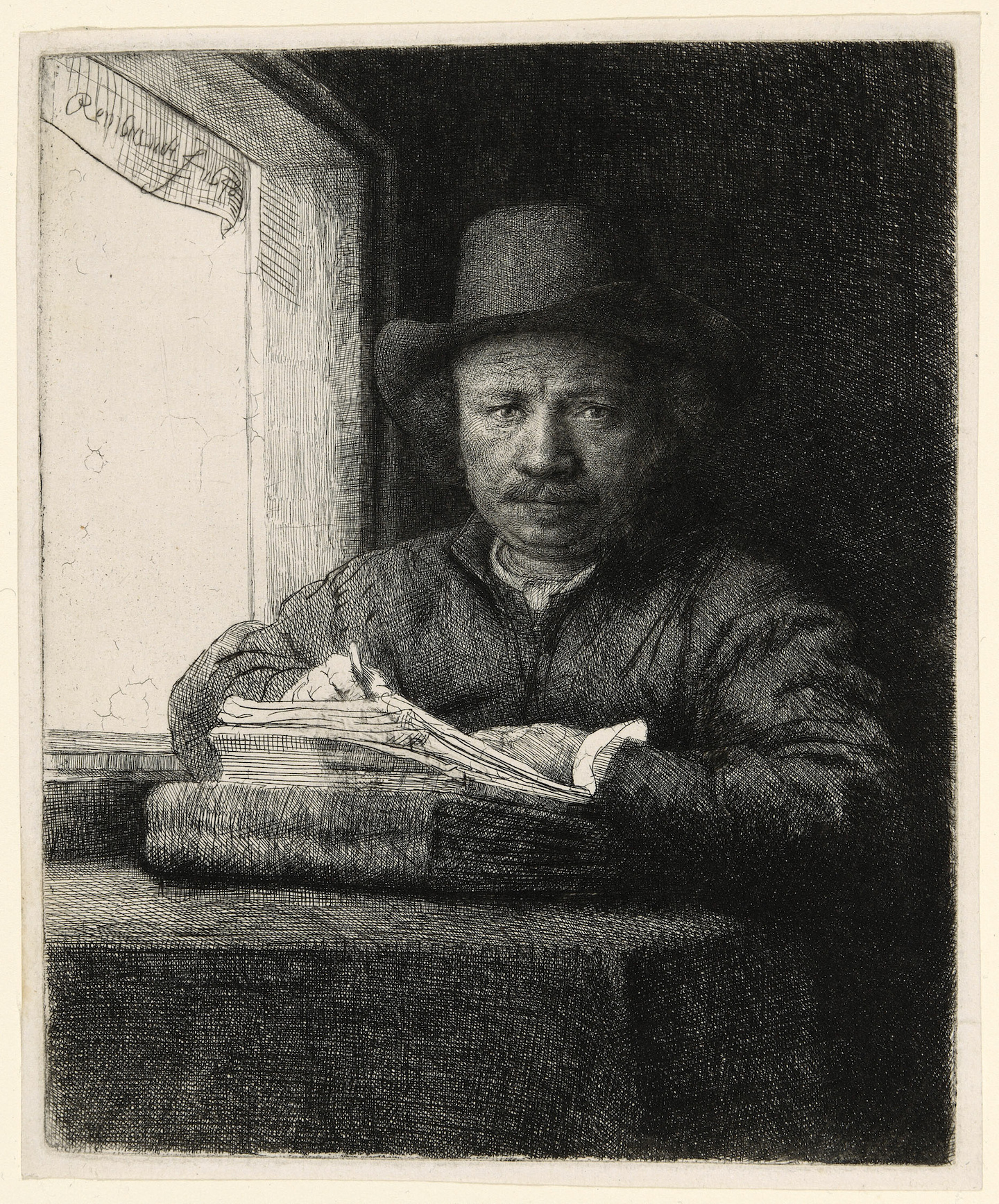
Rembrandt van Rijn, Self-Portrait Drawing at a Window, 1648, etching, drypoint and burin on ivory laid paper, 15.6 x 13 cm (Art Institute of Chicago)
It would be difficult to overestimate the importance of Rembrandt Harmenszoon van Rijn within the history of Western art. Indeed, Rembrandt is considered one of the foremost artists of the Dutch Baroque period, and even if he had never picked up a paintbrush, he would have been famous both in his day and ours as a printmaker of particular brilliance and as a prolific teacher. In a career that lasted nearly forty years, Rembrandt completed approximately 400 paintings, more than 1,000 drawings, and nearly 300 engravings. Although he spent his entire life north of the alps, had he been Italian and lived a century or so earlier, he likely would have joined his Italian brethren—Donatello, Leonardo, Michelangelo, and Raphael, as a member of the famed cartoon Teenage Mutant Ninja Turtles.
Patrons: A wealthy, Protestant, and expanding middle class
But as time and place would have it, Rembrandt was neither Italian nor a part of the Renaissance. Instead, Rembrandt was born in Leiden in 1606. This place and time—Holland during the height of the expansion of the wealthy mercantile class during the middle half of the seventeenth century—served Rembrandt well through his long career. The Catholic Church often commissioned Italian artists at this time to undertake large-scale projects to promote religious ideology in support of the Counter Reformation. Without the Catholic Church in Holland to commission art, Rembrandt and his fellow Dutch artists were lavishly supported by a wealthy, Protestant, and expanding middle class. This group of patrons enthusiastically commissioned works of art with their increasing discretionary income.
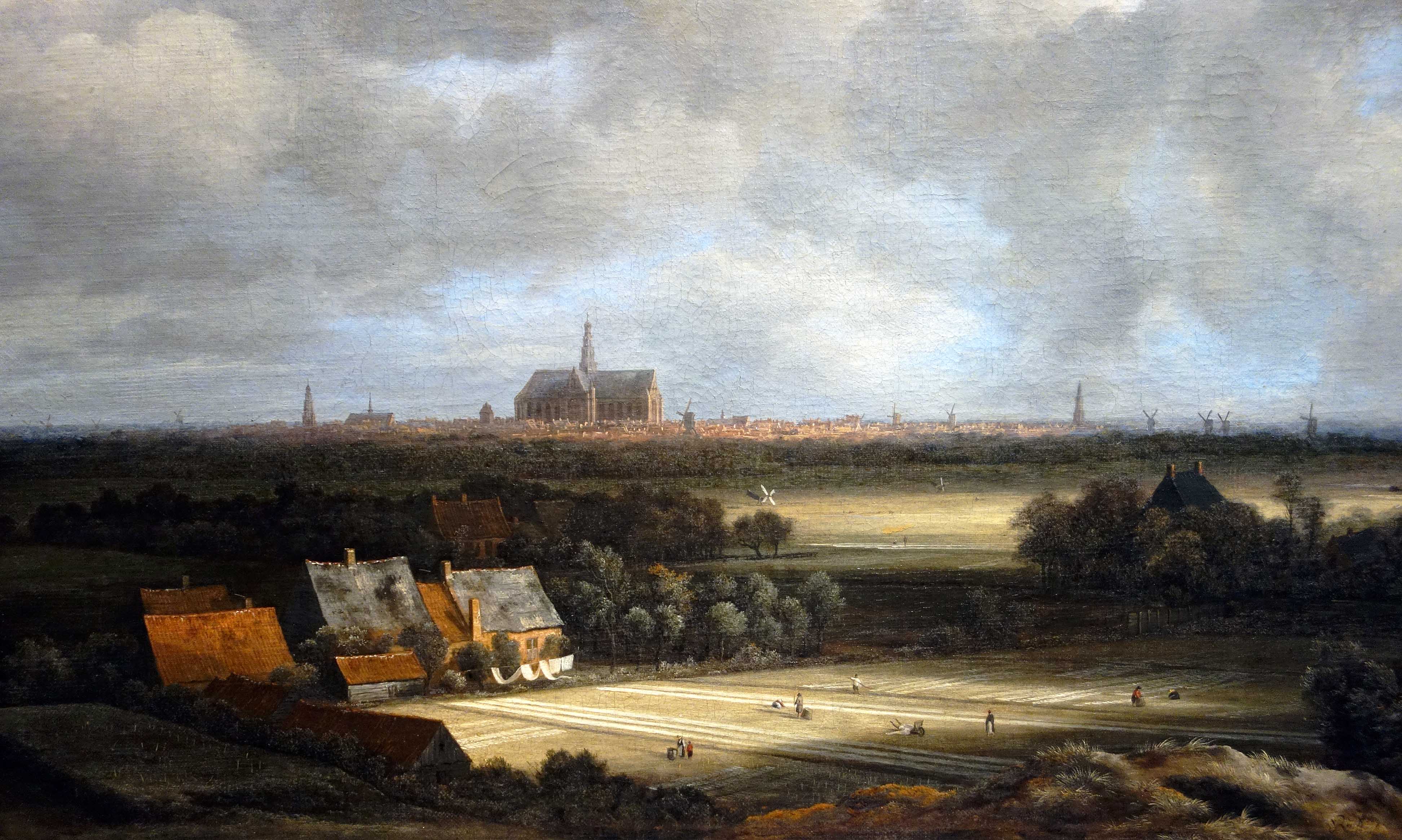
Jacob van Ruisdael, View of Haarlem with Bleaching Grounds, c. 1670–75, oil on canvas, 55.5 x 62 cm (Mauritshuis, The Hague, Netherlands)
New subjects (including group portraits)
Many different types of art became popular during the Dutch Baroque period. Genre paintings—small paintings of everyday life—were exceptionally popular with a middle-class clientele, as were still lifes, landscapes, and prints. The majority of these kinds of art were both affordable and small enough to be easily displayed within an average home. Larger and more compositionally complicated, group portraiture also became popular in Holland during the seventeenth century. This was a mode of painting that was often placed in a public space so that the image could promote a particular organization.
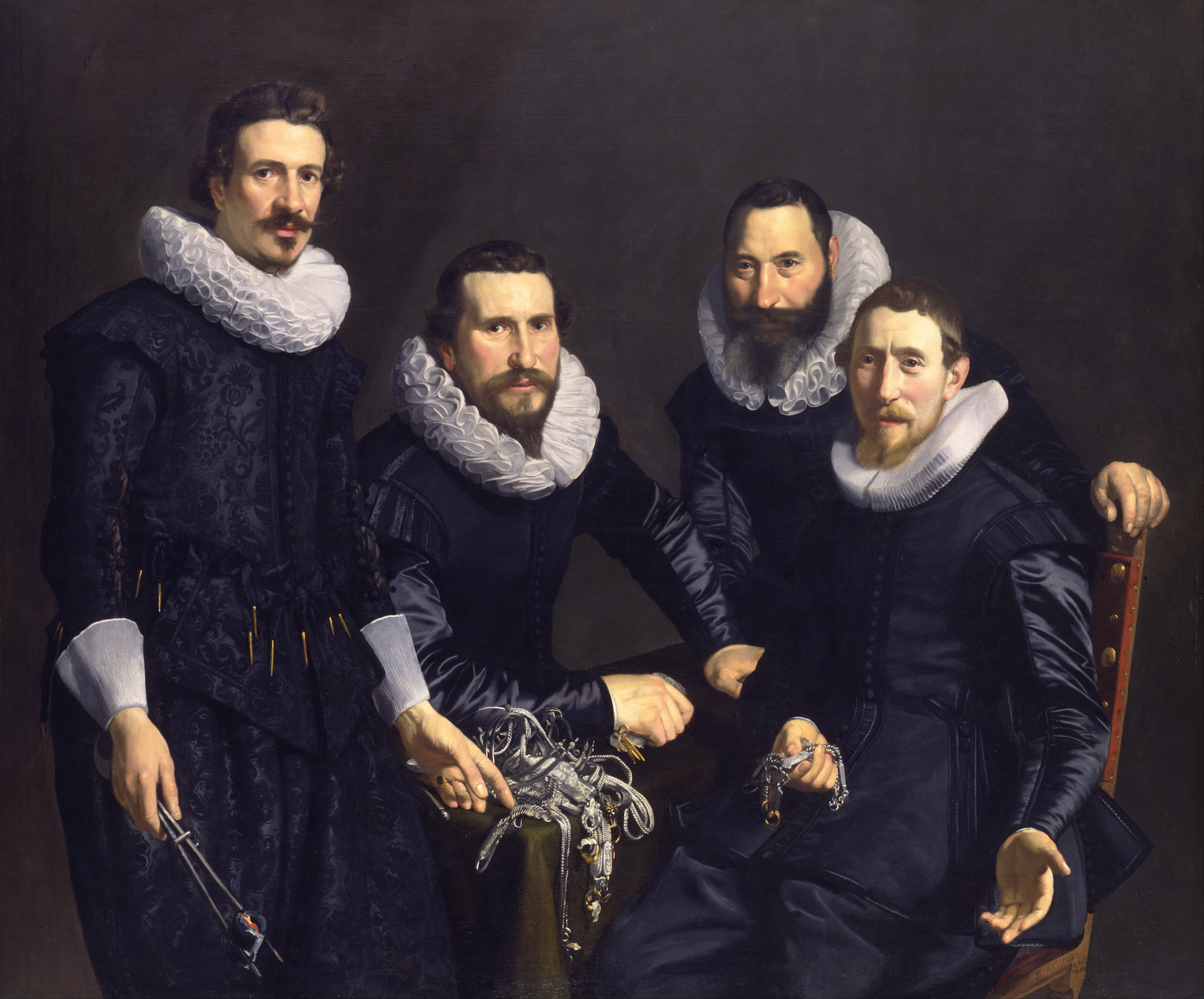
Thomas de Keyser, Syndics of the Amsterdam Goldsmiths Guild, 1627, oil on canvas, 127.2 x 152.4 cm (Toledo Museum of Art)
Relocating to Amsterdam
Although several of Rembrandt’s most well-known paintings are group portraits—The Anatomy Lesson of Dr. Tulp among others—his early education in Leiden, first at a Latin school and then later at the university, suggest that he was destined for a vocation other than art. However, by the time he was sixteen he decided he wanted to be a painter and a draughtsman. After finding quick success in Leiden during the 1620s, Rembrandt relocated to Amsterdam in 1631, a wise professional decision, as this was then one of the wealthiest and largest cities in Europe.
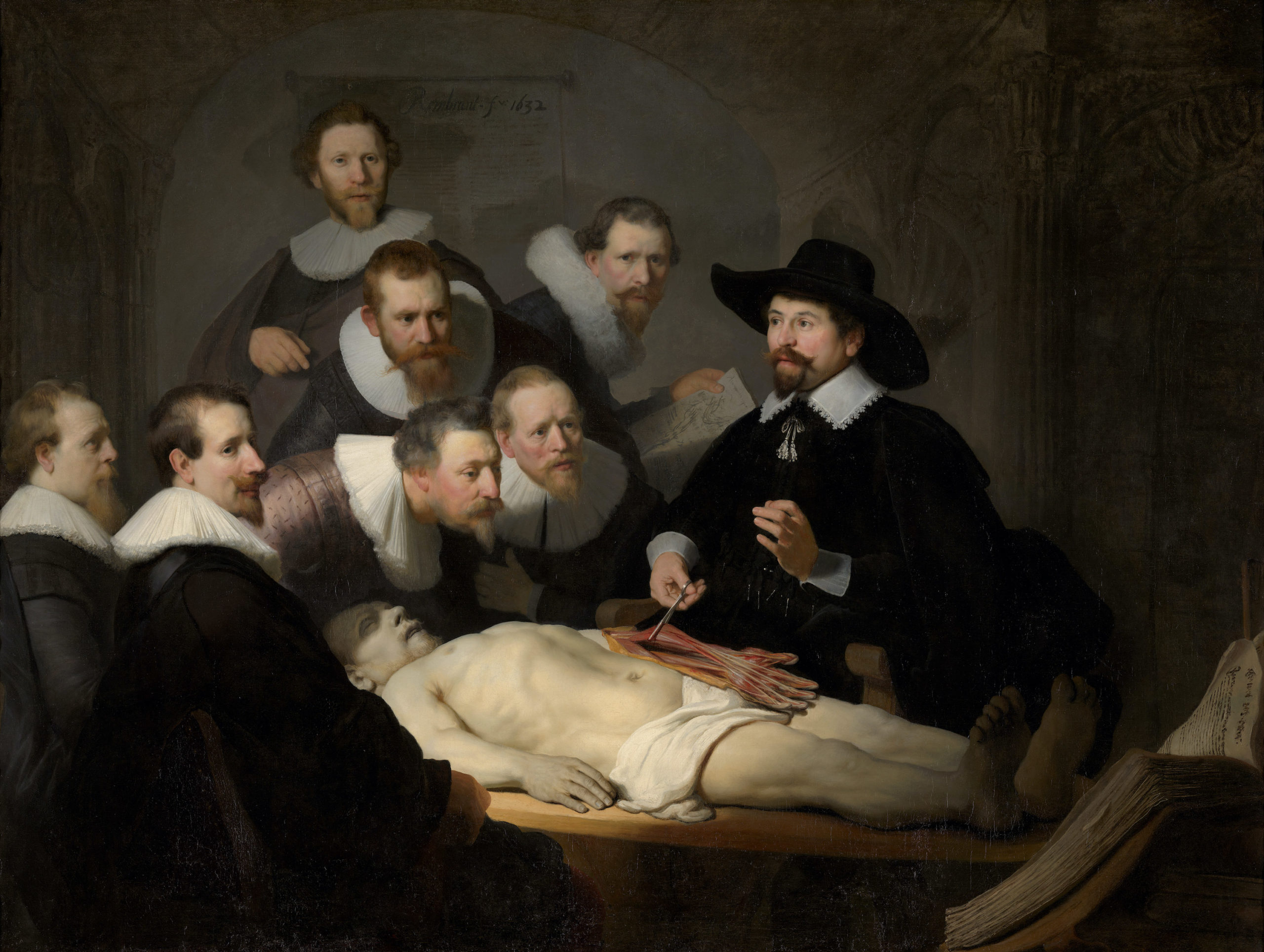
Rembrandt van Rijn, The Anatomy Lesson of Dr. Tulp, 1632, oil on canvas, 169.5 x 216.5 cm (Mauritshuis, The Hague, Netherlands)
A group portrait for the Amsterdam Surgeon’s Guild
Just a year after his arrival, Rembrandt was offered the commission to complete a group portrait of the Amsterdam Surgeon’s Guild, an image that in time has come to be known rather simply as The Anatomy Lesson of Dr. Tulp. It is remarkable that Rembrandt received this commission as a newcomer to Amsterdam when there were other native-born artists available. Thomas de Keyser and Nicolaes Pickenoy, for example, were older and more experienced in the realm of group portraiture. Whereas another artist may have simply recreated a previous group image—inserting new heads in place of old ones—Rembrandt created something new, and in doing so, completed one of the most recognizable images in the history of painting.
Dr. Nicolaes Tulp
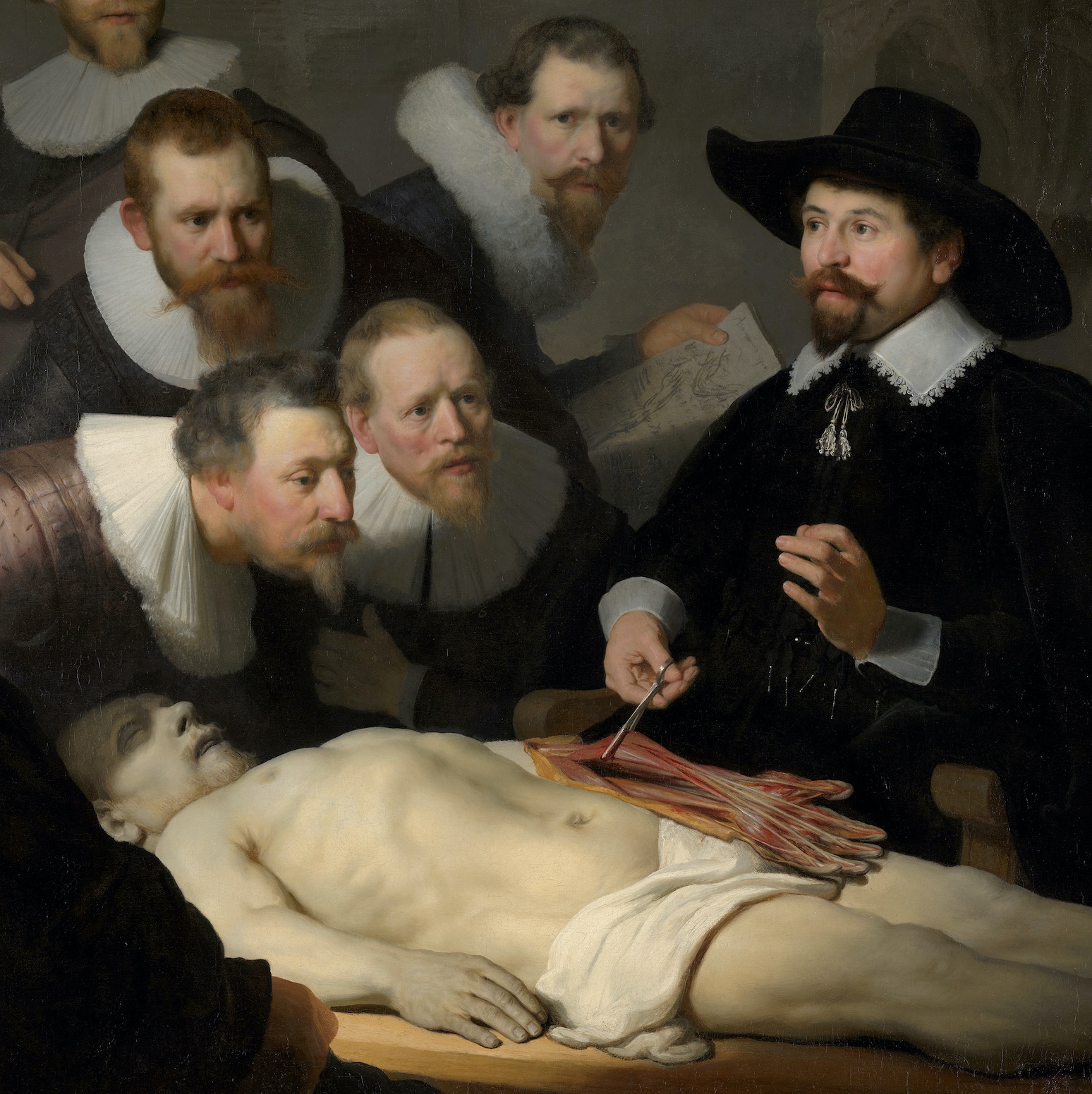
Dr. Tulp displaying the flexors in a cadaver’s arm (detail), Rembrandt van Rijn, The Anatomy Lesson of Dr. Tulp, 1632, oil on canvas, 169.5 x 216.5 cm (Mauritshuis, The Hague, Netherlands)
Dr. Nicolaes Tulp was appointed praelector (like a professor or lecturer) of the Amsterdam Anatomy Guild in 1628. One of the responsibilities of this position was to deliver a yearly public lecture on some aspect of human anatomy. The lecture in 1632 occurred on 16 January, and this is the scene that Rembrandt depicts in paint in The Anatomy of Lesson of Dr. Tulp.
This is a more complicated composition than it at first appears. Understandably, the focal point of the image is Dr. Tulp, the doctor who is shown displaying the flexors of the cadaver’s left arm. Rembrandt notes the doctor’s significance by showing him as the only person who wears a hat. Seven colleagues surround Dr. Tulp, and they look in a variety of directions—some gaze at the cadaver, some stare at the lecturer, and some peek directly at the viewer. Each face displays a facial expression that is deeply personal and psychological. The cadaver—a recently executed thief named Adriaen Adriaenszoon—lies nearly parallel to the picture plane. Viewing the illuminated body from his head to his feet brings into focus a book—likely Andreas Vesalius’s De humani corporis fabrica (Fabric of the Human Body, 1543)—propped up in the lower right corner. In all, Rembrandt shows nine distinct figures, but does so as if they are a unified group.
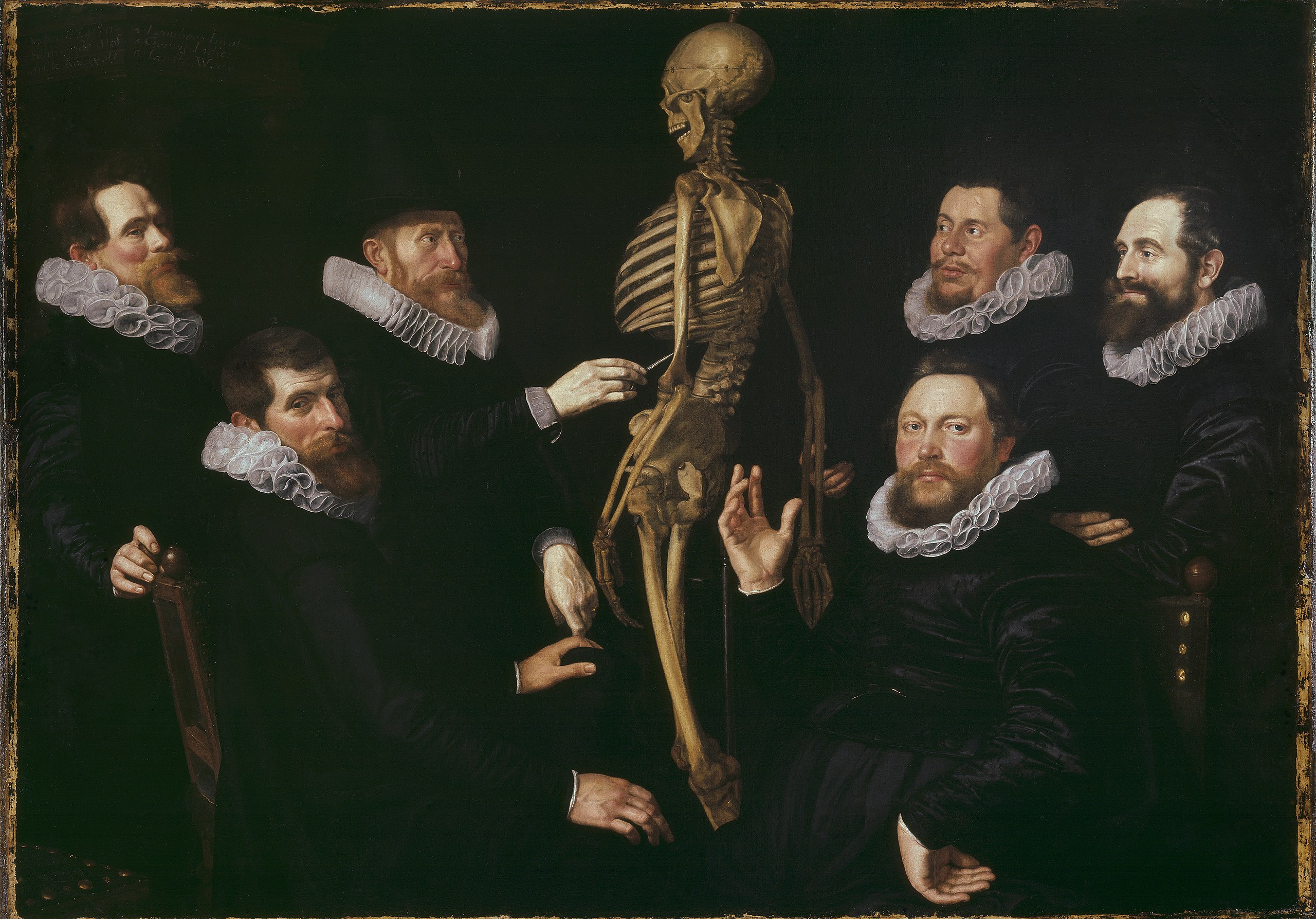
Thomas de Keyser or Nicolaes Eliaszoon Pickenoy, The Osteology Lesson of Dr. Sebastiaen Egbertsz, 1619, oil on canvas, 135 x 186 cm (Amsterdam Historical Museum; photo: Never covered)
A comparison
Comparing The Anatomy Lesson of Dr. Tulp to a somewhat similar example, The Osteology Lesson of Dr. Sebastiaen Egbertszoon, shows just how different and novel Rembrandt’s composition was at the time. The Sebastiaen Erbertszoon painting is a series of six portraits that surround a single human skeleton, but neither the heads nor the bodies seem to interact with one another in a real or coherent way. In contrast, the figures in Rembrandt’s Tulp seem to truly be a group, one collection of nine rather than nine individuals.
If the composition is different from what Rembrandt might have seen in Amsterdam, the choice of subject is different than what would have been expected in the parts of Europe that were Catholic. The Catholic tenet of resurrection necessitated that dead bodies be interred in a state of wholeness, and this fact explains why Leonardo was forced to dissect human bodies in secret. In Protestant Holland but 113 years after Leonardo’s death, however, human dissections were not only common practice, they were often public spectacles, complete with food and wine, music and conversation.
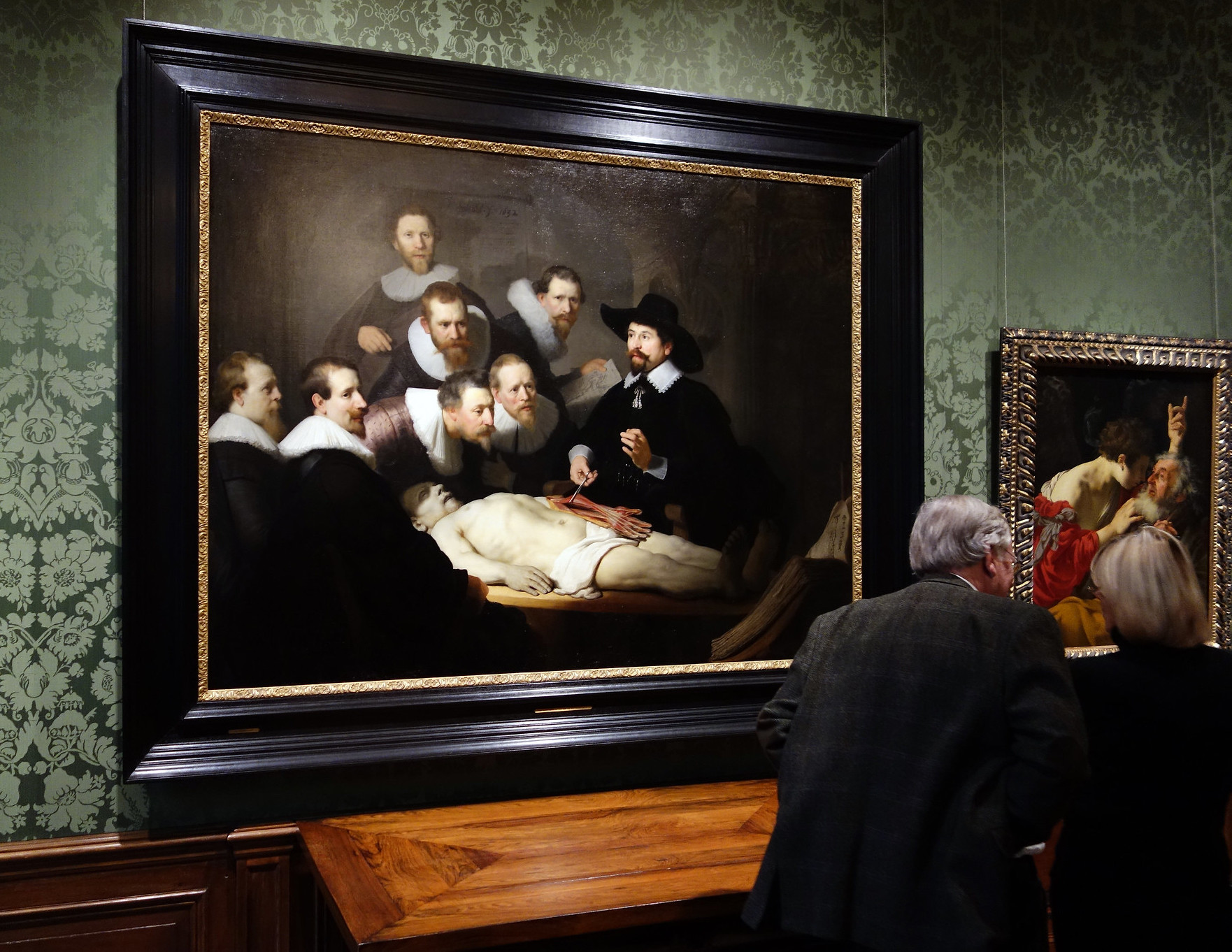
View of Rembrandt van Rijn, The Anatomy Lesson of Dr. Tulp, 1632, oil on canvas, 169.5 x 216.5 cm (Mauritshuis, The Hague, Netherlands; photo: Steven Zucker, CC BY-NC-SA 2.0)
Artistic license
If Rembrandt was able to create a truly group portrait—one of a single group rather than a collection of individuals—it is important to note that the artist took some understandable artistic license with some parts of the composition. As any anatomy and physiology student today can attest, a dissection of the human body almost always commences with an exploration of the chest and abdominal areas, parts of the human body most likely to decompose first, and only later does the procedure move onwards to the limbs. Moreover, it would have been unlikely that a doctor of Tulp’s importance would have actually dissected the body; instead, he would have lectured while the menial task of exposing the inner workings of the body would have been left to others. But in paint, a format without sound, Rembrandt put Tulp in charge not only in costume, but also in action.
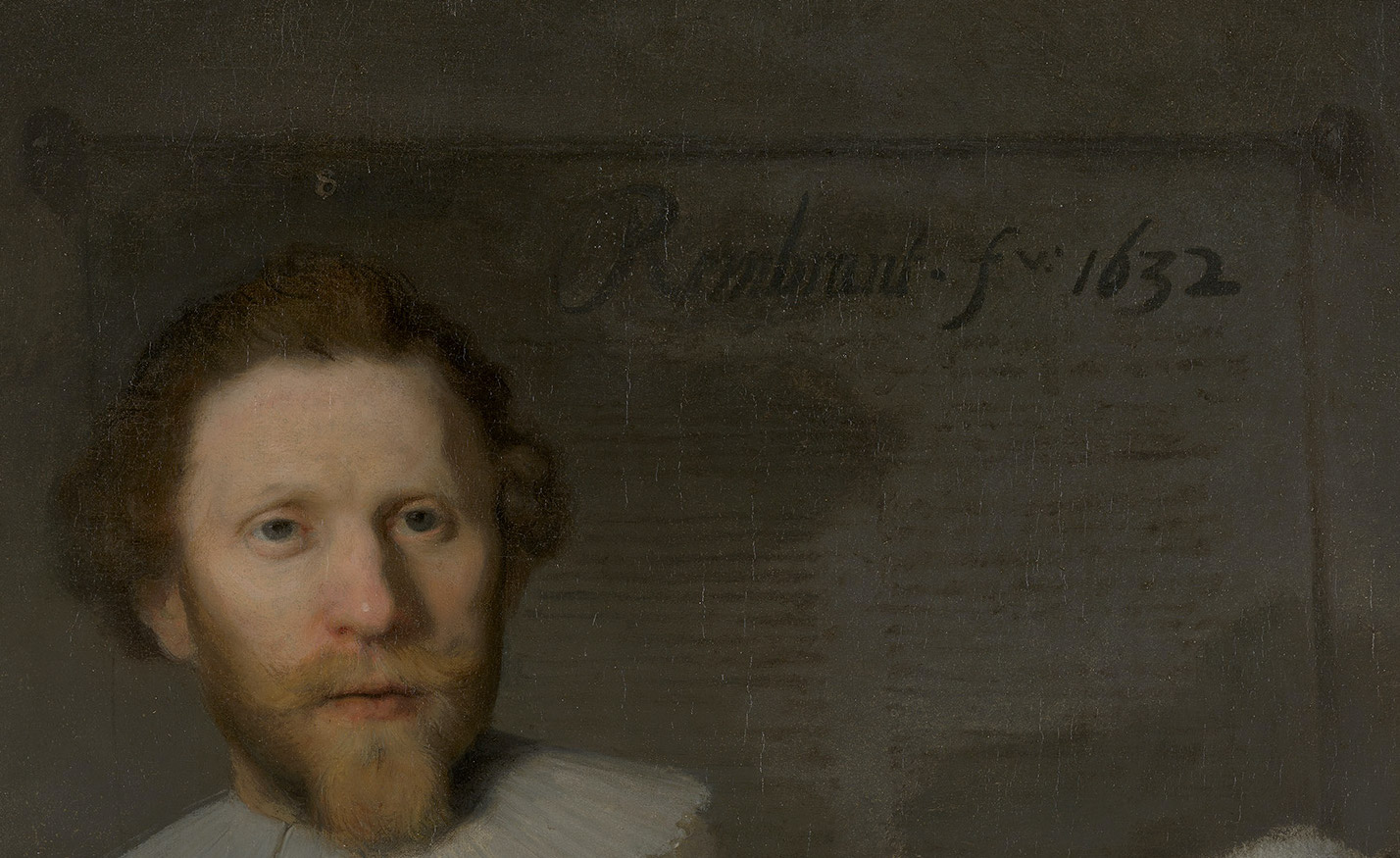
Rembrandt’s signature prominently displayed (detail), The Anatomy Lesson of Dr. Tulp, 1632, oil on canvas, 169.5 x 216.5 cm (Mauritshuis, The Hague, Netherlands)
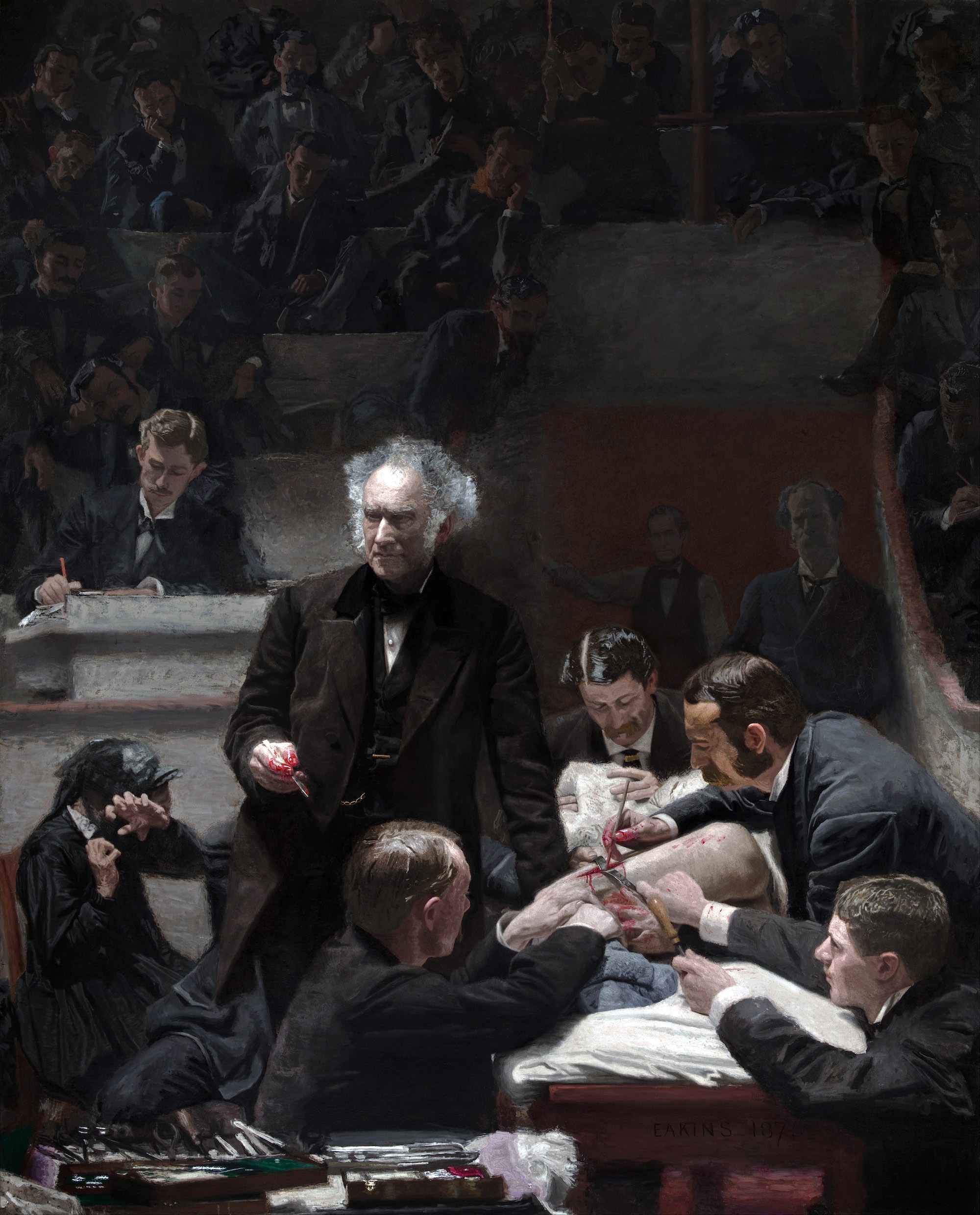
Thomas Eakins, Portrait of Dr. Samuel D. Gross (The Gross Clinic), 1875, oil on canvas, 243.8 x 198.1 cm (Philadelphia Museum of Art)
As the prominent signature in the upper part of the painting indicates, Rembrandt was justifiably proud of this large painting. Whereas he had previously signed his works with his monogram RHL (Rembrandt Harmenszoon of Leiden), The Anatomy Lesson of Dr. Tulp contains “Rembrant. f[ecit] 1632.” This painting and the Latin announcement that “Rembrandt made it” marks the beginning of the painter’s mature career.
Daring, compositionally innovative, and deeply psychological, The Anatomy Lesson of Dr. Tulp launched Rembrandt to fame and wealth and influenced generations of artists to come. Indeed, without Tulp, it seems impossible for Thomas Eakins to have painted The Gross Clinic almost two and a half centuries later.

